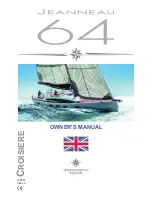
• Attach the Emergency Safety Lanyard to a secure place on your clothing, your arm or your leg while
operating.
• DO NOT
attach the lanyard to clothing that could tear loose.
• DO NOT
route the lanyard where it could become entangled, preventing it from functioning.
• Avoid accidentally pulling the lanyard during normal operation.
• Loss of engine power means loss of most steering control.
• Without engine power, the boat will decelerate rapidly. This could cause people in the boat to be thrown
forward or ejected overboard if they are not properly seated in the boat.
There are practical limitations to what the Emergency Safety Lanyard can do. It can take several seconds for the
engine and propeller to stop turning. The boat can continue to coast for several hundred feet depending on the boat
speed at the time the switch is activated. While the boat is coasting, it can cause injury to anyone in its path. Accidental
loss of power can be hazardous particularly when docking or in heavy seas, strong current, or high winds.
While at the dock or when the boat is not moving, periodically disconnect/pull the Emergency Safety Lanyard out
of the switch while the engine is running to test for proper operation. The engine should shut off when the lanyard is
disconnected/pulled from the switch. You should not be able to restart the engine until the lanyard is back in place.
Personal Flotation Devices
Federal law requires that you have at least one wearable Personal Flotation Device (PFD) of the proper size
(Type I, II, III or V), for each person on board or being towed, and at least one throwable PFD (Type IV) in the boat.
PFDs must be Coast Guard approved, in good and serviceable condition and the appropriate size for the user.
To meet requirements, each lifesaving device must have a current, legible USCG approval stamp permanently
affixed. At the beginning of each season, inspect life jackets (PFDs) for damage and test for proper flotation. Refer
to the life jacket (PFD) manufacturer’s information.
REMEMBER-—The best PFD is the one that is worn—that is, the one that can save your life.
PFDs are
intended to save lives; it is highly recommended that you and your passengers wear them while in the boat.
Learn how to use them and adjust as necessary for comfort. It is especially important that children and non-
swimmers wear a life jacket (PFD) at all times. Make certain all passengers know where life jackets are located,
how to put on and properly adjust their life jackets (PFDs), and that life jackets are readily accessible at all times.
Your dealer can help you select appropriate life jackets (PFDs) and throwable lifesaving devices for your area.
Some PFDs are specially made for use while water skiing or wakeboarding and are not U.S.C.G.-approved. Please
check local law with respect to their use. Some states require children to wear a PFD at
all times. There are four types of wearable PFDs (Type I, II, III or V) and one throwable
type of PFD (Type IV) used for throwing in emergency situations. Examples of these
USCG approved PFDs are shown:
Type I PFD —Offshore Life Jacket:
This PFD is designed for
extended survival in rough, open water. It usually will turn
an unconscious person face up and has over 22 pounds of
buoyancy. This is the best PFD to keep you afloat in remote
regions where rescue may be slow in coming.
Type II PFD—Near Shore Buoyant Vest:
This “classic” PFD
comes in several sizes for adults and children and is for calm
inland water where there is chance of fast rescue. It is less bulky and less expensive than
a Type I, and many will turn an unconscious person face up in the water.
2020 Malibu Boats LLC • Owner’s Manual • Page 13
Type I
Type II
Summary of Contents for 21 VLX
Page 4: ......
Page 16: ...Safety ...
Page 17: ......
Page 42: ...2020 Malibu Boats LLC Owner s Manual Page 28 Wakesetter Label Locations ...
Page 88: ...Dashes and Video Screens ...
Page 89: ......
Page 134: ...Engine and ...
Page 135: ...Drive Train ...
Page 156: ...How It Works ...
Page 157: ......
Page 195: ...2020 Malibu Boats LLC Owner s Manual Page 181 ...
Page 196: ...Trailers ...
Page 197: ......
Page 224: ...2020 Malibu Boats LLC Owner s Manual Page 210 ...
Page 226: ......
Page 227: ...Get Ready ...
Page 238: ...Care and ...
Page 239: ...Maintenance ...
Page 278: ...Warranty ...
Page 279: ......
Page 301: ...2020 Malibu Boats LLC Owner s Manual Page 287 Date Date Date Date Date Date Date Date ...
















































